2003 FORD ESCAPE climate control
[x] Cancel search: climate controlPage 1 of 240

Introduction 4
Instrument Cluster 10
Warning and control lights 10
Gauges 13
Entertainment Systems 15
AM/FM stereo with CD 26
AM/FM stereo cassette with CD 18
Climate Controls 30
Heater only 30
Manual heating and air conditioning 31
Lights 33
Headlamps 33
Turn signal control 36
Bulb replacement 38
Driver Controls 43
Windshield wiper/washer control 43
Steering wheel adjustment 45
Power windows 48
Mirrors 49
Speed control (Cruise control) 49
Table of Contents
1
Page 30 of 240
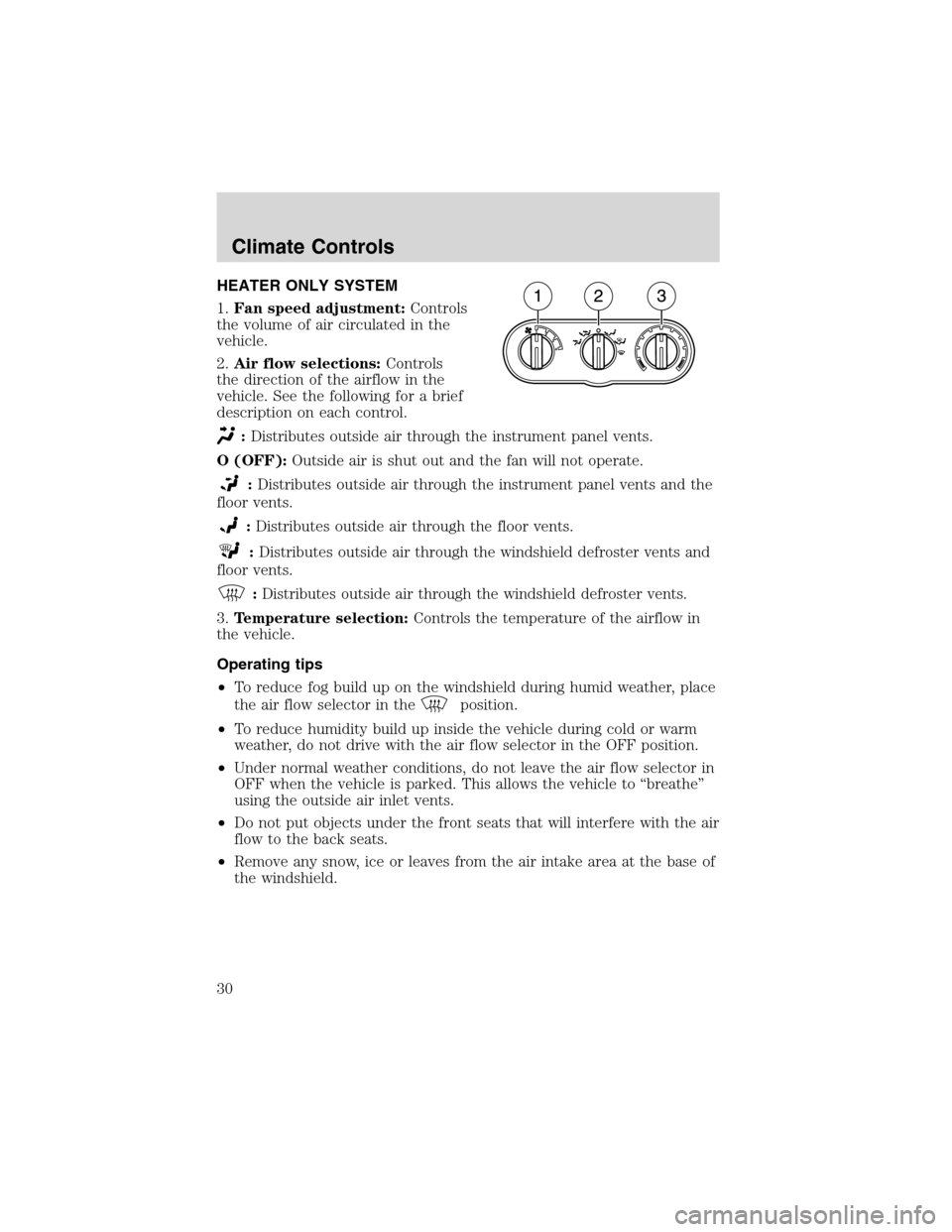
HEATER ONLY SYSTEM
1.Fan speed adjustment:Controls
the volume of air circulated in the
vehicle.
2.Air flow selections:Controls
the direction of the airflow in the
vehicle. See the following for a brief
description on each control.
:Distributes outside air through the instrument panel vents.
O (OFF):Outside air is shut out and the fan will not operate.
:Distributes outside air through the instrument panel vents and the
floor vents.
:Distributes outside air through the floor vents.
:Distributes outside air through the windshield defroster vents and
floor vents.
:Distributes outside air through the windshield defroster vents.
3.Temperature selection:Controls the temperature of the airflow in
the vehicle.
Operating tips
•To reduce fog build up on the windshield during humid weather, place
the air flow selector in the
position.
•To reduce humidity build up inside the vehicle during cold or warm
weather, do not drive with the air flow selector in the OFF position.
•Under normal weather conditions, do not leave the air flow selector in
OFF when the vehicle is parked. This allows the vehicle to“breathe”
using the outside air inlet vents.
•Do not put objects under the front seats that will interfere with the air
flow to the back seats.
•Remove any snow, ice or leaves from the air intake area at the base of
the windshield.
Climate Controls
30
Page 31 of 240
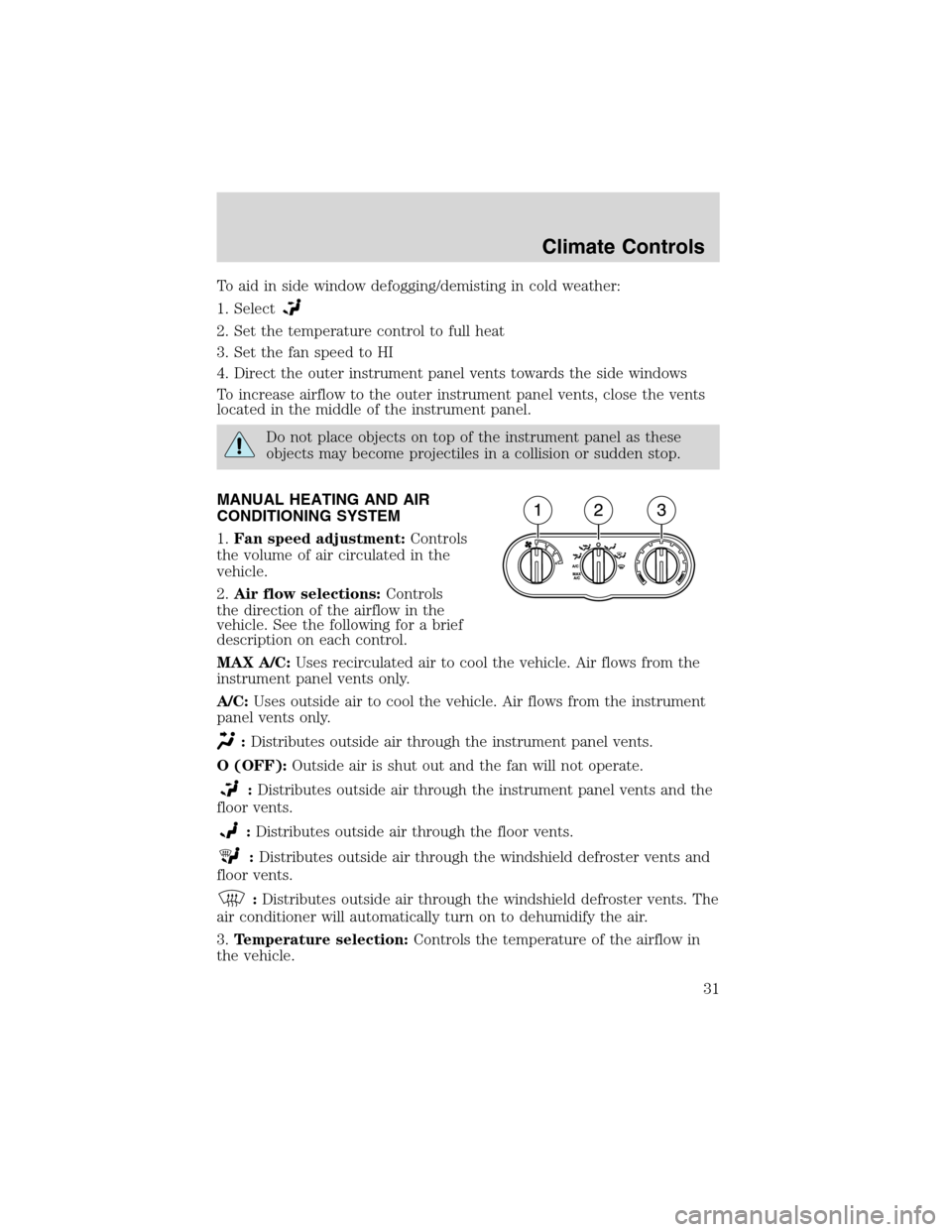
To aid in side window defogging/demisting in cold weather:
1. Select
2. Set the temperature control to full heat
3. Set the fan speed to HI
4. Direct the outer instrument panel vents towards the side windows
To increase airflow to the outer instrument panel vents, close the vents
located in the middle of the instrument panel.
Do not place objects on top of the instrument panel as these
objects may become projectiles in a collision or sudden stop.
MANUAL HEATING AND AIR
CONDITIONING SYSTEM
1.Fan speed adjustment:Controls
the volume of air circulated in the
vehicle.
2.Air flow selections:Controls
the direction of the airflow in the
vehicle. See the following for a brief
description on each control.
MAX A/C:Uses recirculated air to cool the vehicle. Air flows from the
instrument panel vents only.
A/C:Uses outside air to cool the vehicle. Air flows from the instrument
panel vents only.
:Distributes outside air through the instrument panel vents.
O (OFF):Outside air is shut out and the fan will not operate.
:Distributes outside air through the instrument panel vents and the
floor vents.
:Distributes outside air through the floor vents.
:Distributes outside air through the windshield defroster vents and
floor vents.
:Distributes outside air through the windshield defroster vents. The
air conditioner will automatically turn on to dehumidify the air.
3.Temperature selection:Controls the temperature of the airflow in
the vehicle.
Climate Controls
31
Page 32 of 240
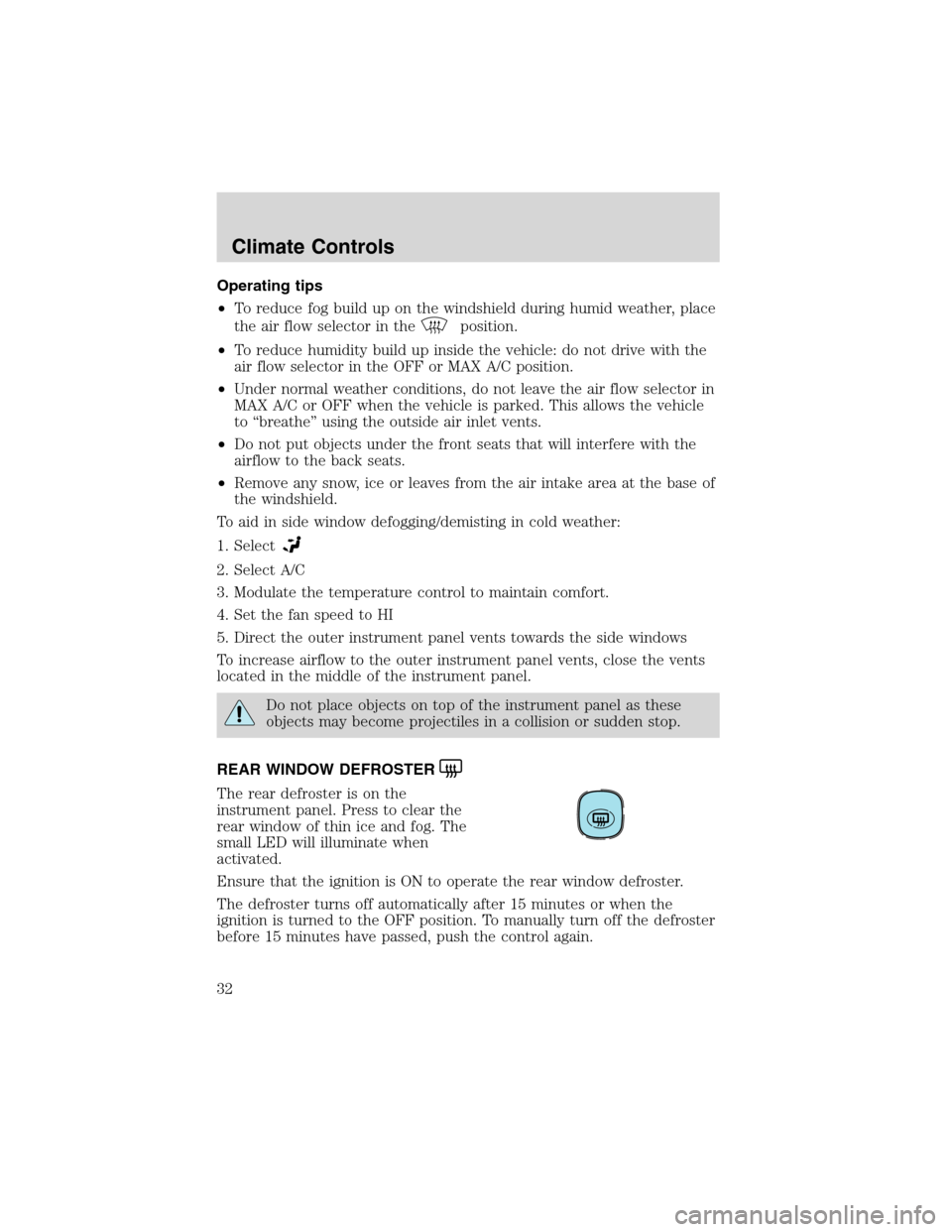
Operating tips
•To reduce fog build up on the windshield during humid weather, place
the air flow selector in the
position.
•To reduce humidity build up inside the vehicle: do not drive with the
air flow selector in the OFF or MAX A/C position.
•Under normal weather conditions, do not leave the air flow selector in
MAX A/C or OFF when the vehicle is parked. This allows the vehicle
to“breathe”using the outside air inlet vents.
•Do not put objects under the front seats that will interfere with the
airflow to the back seats.
•Remove any snow, ice or leaves from the air intake area at the base of
the windshield.
To aid in side window defogging/demisting in cold weather:
1. Select
2. Select A/C
3. Modulate the temperature control to maintain comfort.
4. Set the fan speed to HI
5. Direct the outer instrument panel vents towards the side windows
To increase airflow to the outer instrument panel vents, close the vents
located in the middle of the instrument panel.
Do not place objects on top of the instrument panel as these
objects may become projectiles in a collision or sudden stop.
REAR WINDOW DEFROSTER
The rear defroster is on the
instrument panel. Press to clear the
rear window of thin ice and fog. The
small LED will illuminate when
activated.
Ensure that the ignition is ON to operate the rear window defroster.
The defroster turns off automatically after 15 minutes or when the
ignition is turned to the OFF position. To manually turn off the defroster
before 15 minutes have passed, push the control again.
Climate Controls
32
Page 214 of 240
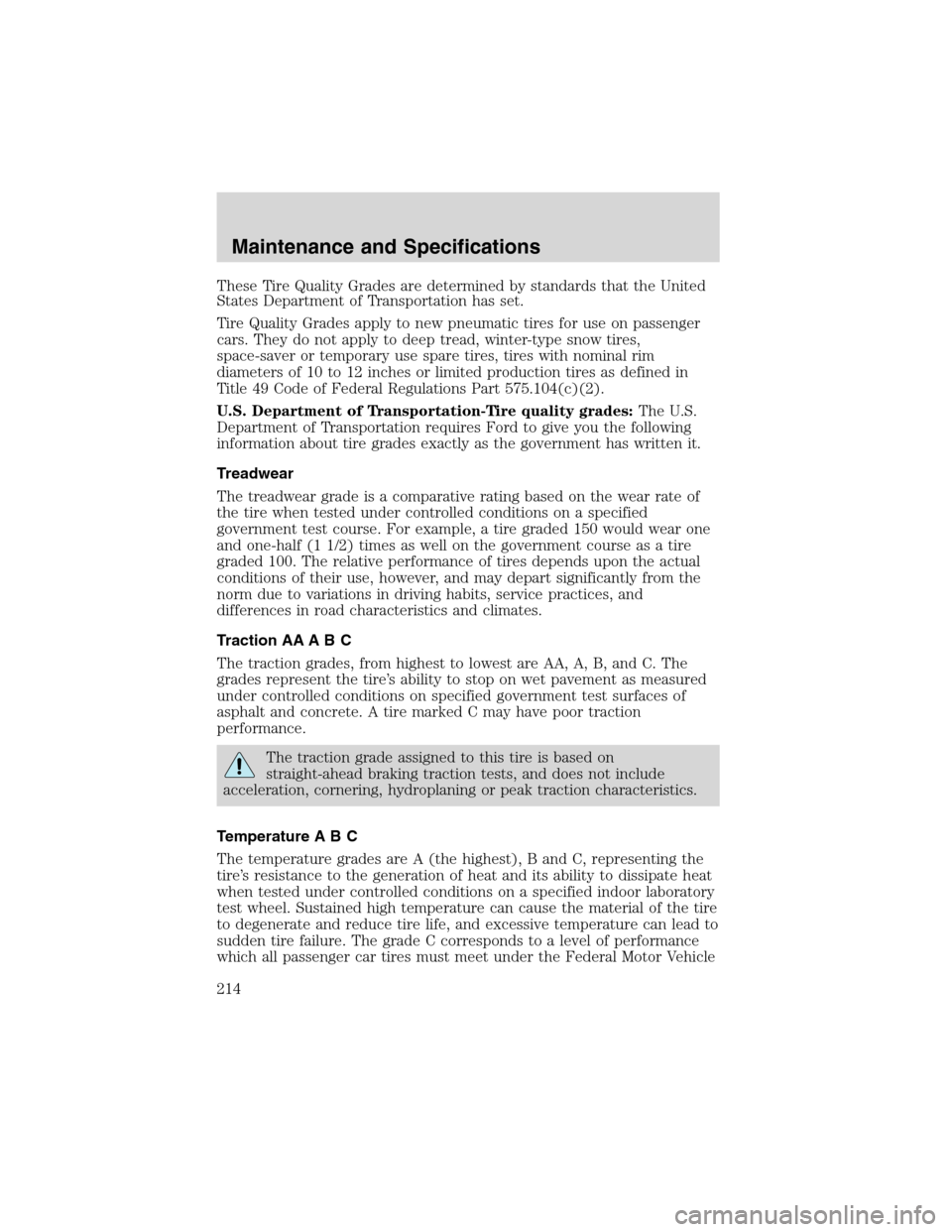
These Tire Quality Grades are determined by standards that the United
States Department of Transportation has set.
Tire Quality Grades apply to new pneumatic tires for use on passenger
cars. They do not apply to deep tread, winter-type snow tires,
space-saver or temporary use spare tires, tires with nominal rim
diameters of 10 to 12 inches or limited production tires as defined in
Title 49 Code of Federal Regulations Part 575.104(c)(2).
U.S. Department of Transportation-Tire quality grades:The U.S.
Department of Transportation requires Ford to give you the following
information about tire grades exactly as the government has written it.
Treadwear
The treadwear grade is a comparative rating based on the wear rate of
the tire when tested under controlled conditions on a specified
government test course. For example, a tire graded 150 would wear one
and one-half (1 1/2) times as well on the government course as a tire
graded 100. The relative performance of tires depends upon the actual
conditions of their use, however, and may depart significantly from the
norm due to variations in driving habits, service practices, and
differences in road characteristics and climates.
Traction AA A B C
The traction grades, from highest to lowest are AA, A, B, and C. The
grades represent the tire’s ability to stop on wet pavement as measured
under controlled conditions on specified government test surfaces of
asphalt and concrete. A tire marked C may have poor traction
performance.
The traction grade assigned to this tire is based on
straight-ahead braking traction tests, and does not include
acceleration, cornering, hydroplaning or peak traction characteristics.
Temperature A B C
The temperature grades are A (the highest), B and C, representing the
tire’s resistance to the generation of heat and its ability to dissipate heat
when tested under controlled conditions on a specified indoor laboratory
test wheel. Sustained high temperature can cause the material of the tire
to degenerate and reduce tire life, and excessive temperature can lead to
sudden tire failure. The grade C corresponds to a level of performance
which all passenger car tires must meet under the Federal Motor Vehicle
Maintenance and Specifications
214
Page 217 of 240
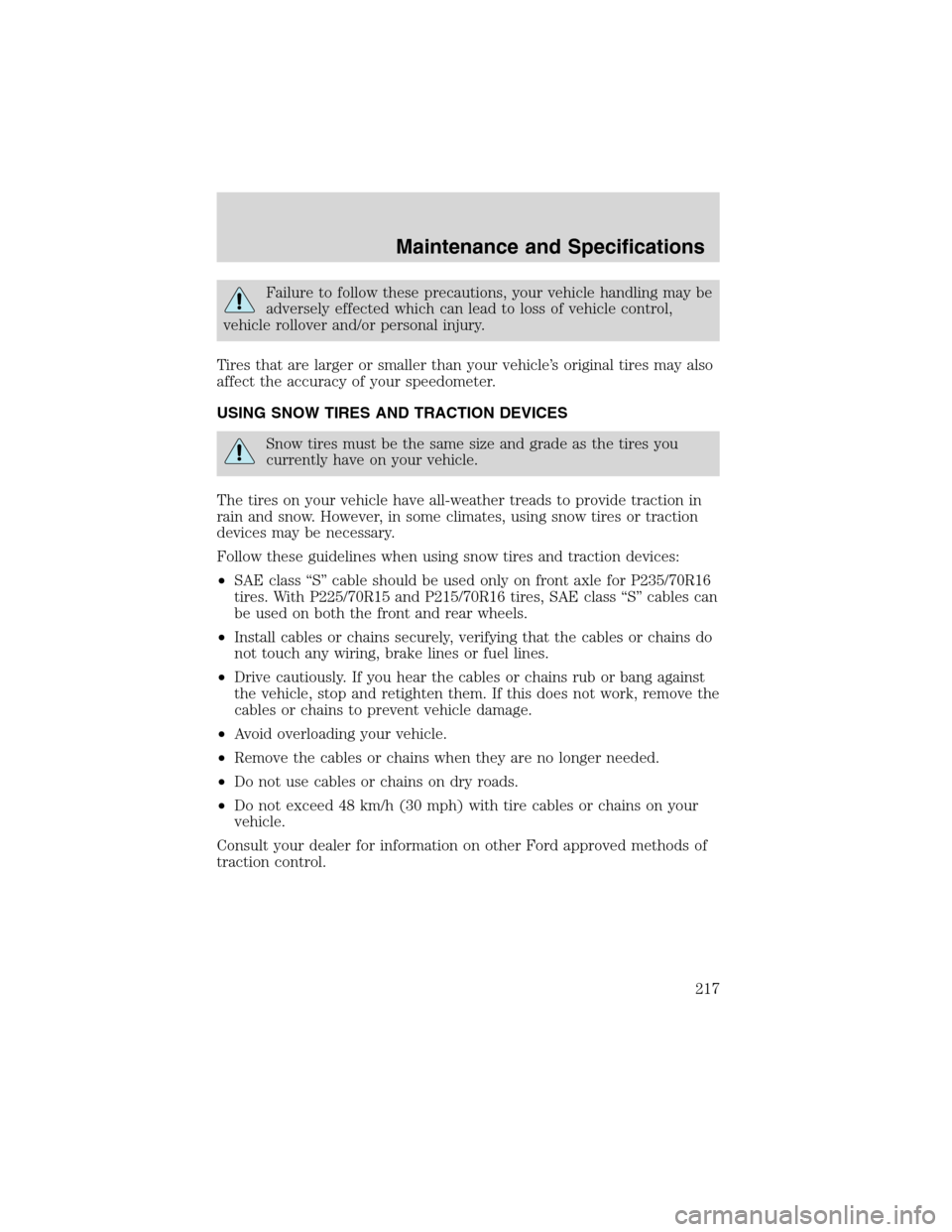
Failure to follow these precautions, your vehicle handling may be
adversely effected which can lead to loss of vehicle control,
vehicle rollover and/or personal injury.
Tires that are larger or smaller than your vehicle’s original tires may also
affect the accuracy of your speedometer.
USING SNOW TIRES AND TRACTION DEVICES
Snow tires must be the same size and grade as the tires you
currently have on your vehicle.
The tires on your vehicle have all-weather treads to provide traction in
rain and snow. However, in some climates, using snow tires or traction
devices may be necessary.
Follow these guidelines when using snow tires and traction devices:
•SAE class“S”cable should be used only on front axle for P235/70R16
tires. With P225/70R15 and P215/70R16 tires, SAE class“S”cables can
be used on both the front and rear wheels.
•Install cables or chains securely, verifying that the cables or chains do
not touch any wiring, brake lines or fuel lines.
•Drive cautiously. If you hear the cables or chains rub or bang against
the vehicle, stop and retighten them. If this does not work, remove the
cables or chains to prevent vehicle damage.
•Avoid overloading your vehicle.
•Remove the cables or chains when they are no longer needed.
•Do not use cables or chains on dry roads.
•Do not exceed 48 km/h (30 mph) with tire cables or chains on your
vehicle.
Consult your dealer for information on other Ford approved methods of
traction control.
Maintenance and Specifications
217
Page 232 of 240
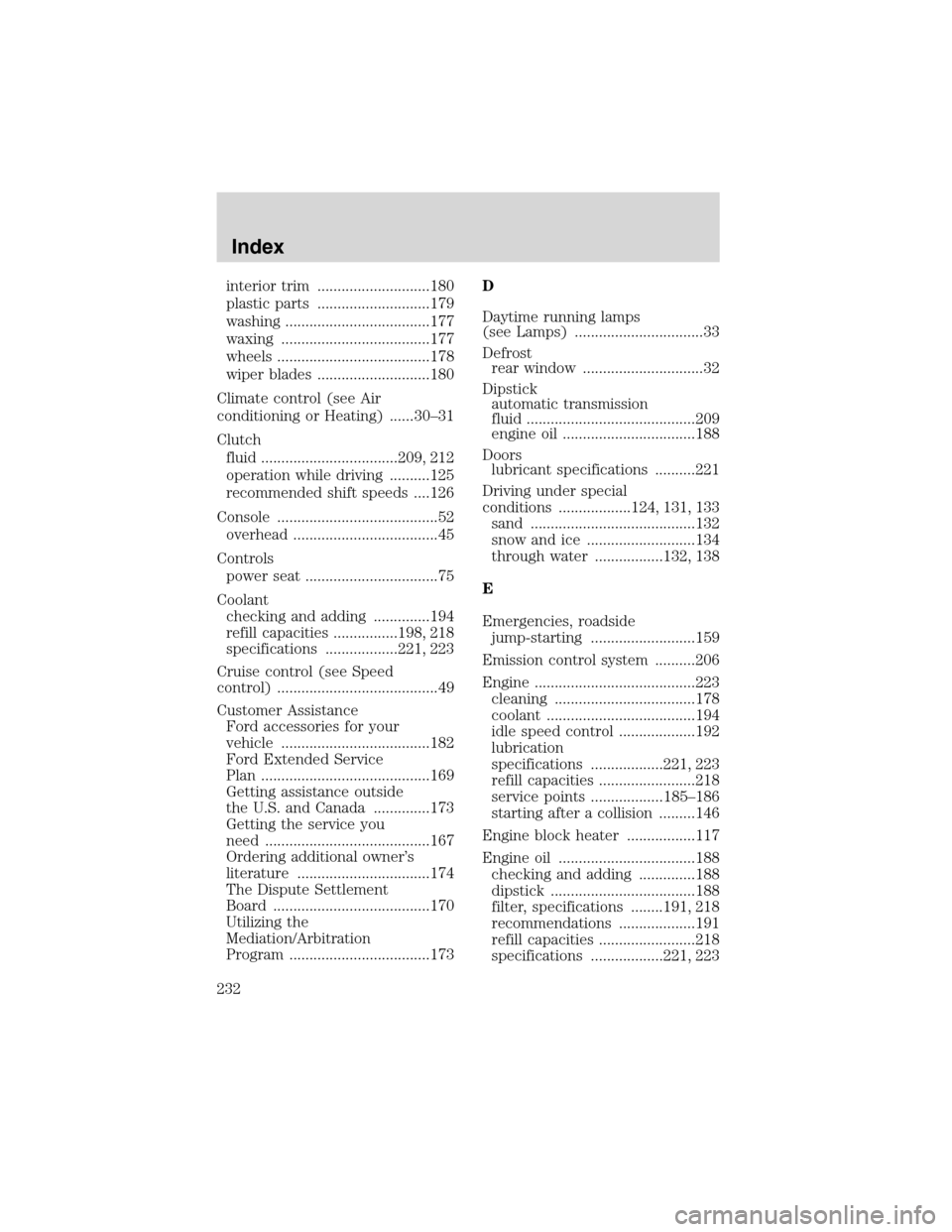
interior trim ............................180
plastic parts ............................179
washing ....................................177
waxing .....................................177
wheels ......................................178
wiper blades ............................180
Climate control (see Air
conditioning or Heating) ......30–31
Clutch
fluid ..................................209, 212
operation while driving ..........125
recommended shift speeds ....126
Console ........................................52
overhead ....................................45
Controls
power seat .................................75
Coolant
checking and adding ..............194
refill capacities ................198, 218
specifications ..................221, 223
Cruise control (see Speed
control) ........................................49
Customer Assistance
Ford accessories for your
vehicle .....................................182
Ford Extended Service
Plan ..........................................169
Getting assistance outside
the U.S. and Canada ..............173
Getting the service you
need .........................................167
Ordering additional owner’s
literature .................................174
The Dispute Settlement
Board .......................................170
Utilizing the
Mediation/Arbitration
Program ...................................173D
Daytime running lamps
(see Lamps) ................................33
Defrost
rear window ..............................32
Dipstick
automatic transmission
fluid ..........................................209
engine oil .................................188
Doors
lubricant specifications ..........221
Driving under special
conditions ..................124, 131, 133
sand .........................................132
snow and ice ...........................134
through water .................132, 138
E
Emergencies, roadside
jump-starting ..........................159
Emission control system ..........206
Engine ........................................223
cleaning ...................................178
coolant .....................................194
idle speed control ...................192
lubrication
specifications ..................221, 223
refill capacities ........................218
service points ..................185–186
starting after a collision .........146
Engine block heater .................117
Engine oil ..................................188
checking and adding ..............188
dipstick ....................................188
filter, specifications ........191, 218
recommendations ...................191
refill capacities ........................218
specifications ..................221, 223
Index
232
Page 235 of 240

Preparing to drive your
vehicle ........................................119
R
Radio ..........................15, 18, 22, 26
Rear window defroster ...............32
Relays ........................................147
Remote entry system
illuminated entry ......................69
locking/unlocking doors ...........63
Reverse sensing system ...........137
Roof rack .....................................55
S
Safety belts (see Safety
restraints) ..............................84–88
Safety defects, reporting ..........176
Safety restraints ....................84–88
belt minder ...............................90
cleaning the safety belts ..........94
extension assembly ..................89
for adults .............................85–87
for children .............................102
lap belt ......................................89
warning light and chime ..........90
Safety seats for children ..........105
Seat belts (see Safety
restraints) ....................................84
Seats ............................................74
child safety seats ....................105
heated ........................................76
Servicing your vehicle ..............183
Snowplowing .................................7
Spare tire (see Changing the
Tire) ...........................................154Spark plugs, specifications ......218,
223
Special notice
ambulance conversions ..............7
utility-type vehicles ....................7
Specification chart,
lubricants ...........................221, 223
Speed control ..............................49
Starting your vehicle .......114–115,
117
jump starting ..........................159
Steering wheel
tilting .........................................45
T
Temperature control
(see Climate control) .................30
Tires ...........................154, 213–215
changing ..........................154–155
checking the pressure ............215
replacing ..................................216
rotating ....................................215
snow tires and chains ............217
tire grades ...............................214
treadwear ................................214
Towing .......................................141
recreational towing .................145
trailer towing ..........................141
wrecker ....................................165
Transaxle
fluid, checking and adding
(manual) .................................211
manual operation ....................125
Transmission .............................120
fluid, checking and adding
(automatic) .............................209
fluid, refill capacities ..............218
lubricant specifications ..221, 223
Index
235